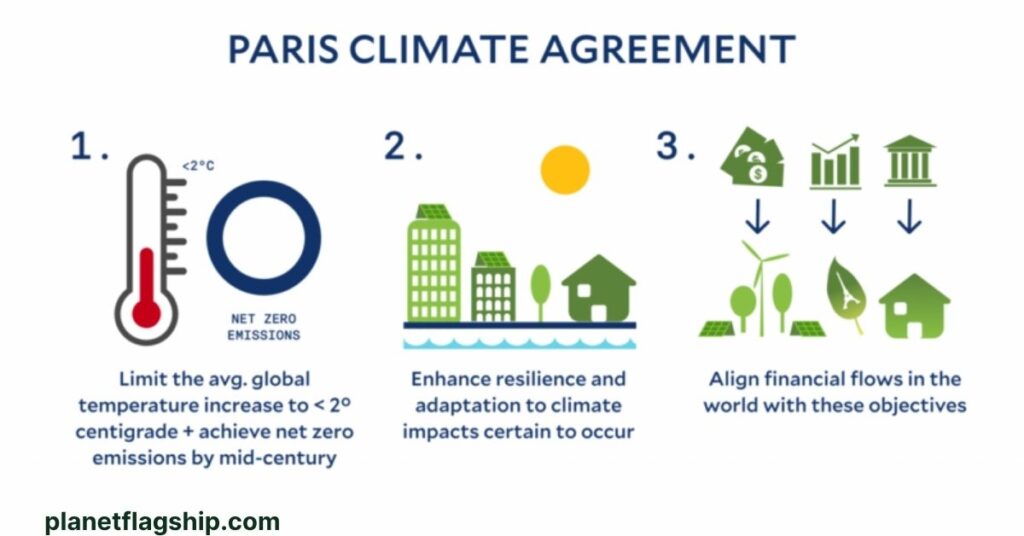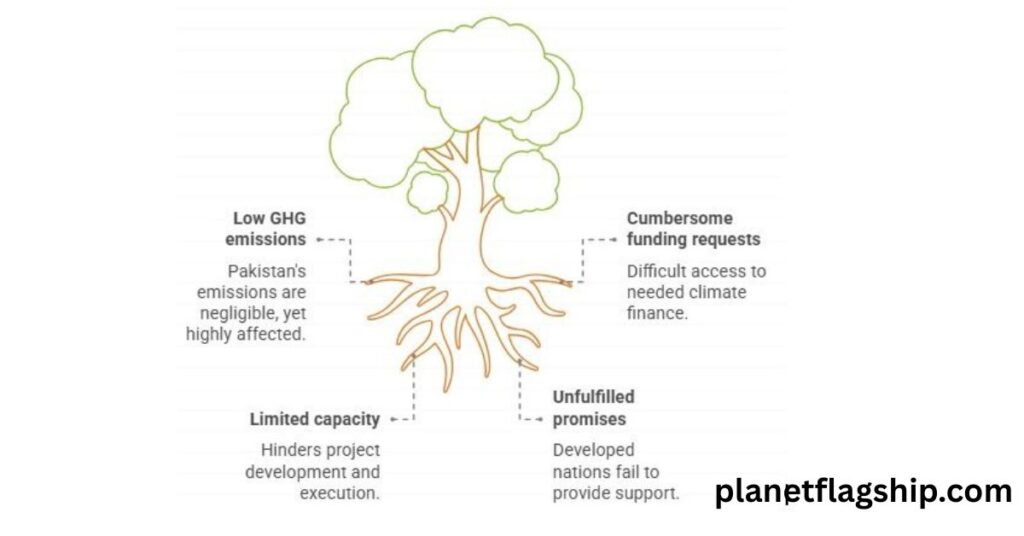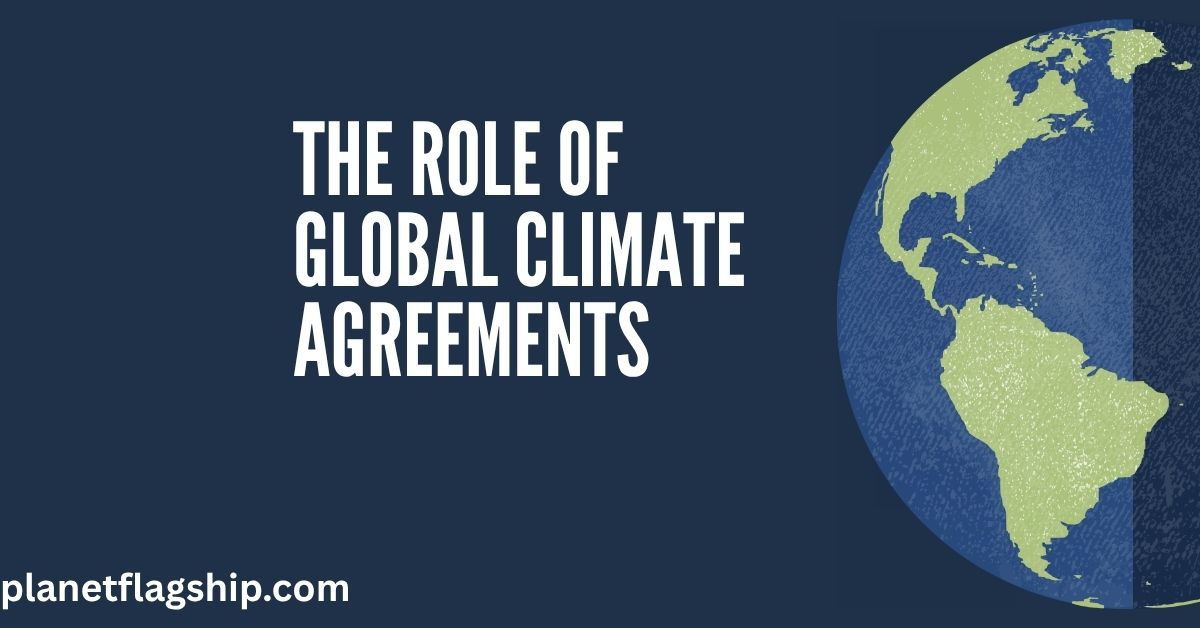Introduction
Global Climate agreements is not just a topic to discuss; it’s an ongoing crisis globally. Not only is it affecting the continents, but it also has a profound impact on living things, especially on human society. The impacts of global warming are growing increasingly severe, leading to sea level rise, wildfires, droughts, and floods. These effects are not occurring naturally but result from socio-economic activities.
Due to these emerging problems, the global community has been implementing numerous treaties to avoid or mitigate the emissions of gases such as greenhouse gases (GHG) and carbon emissions. These arrangements are heading in the right direction, but their effectiveness in mitigating the crisis and its scale remains uncertain.
International climate treaties, such as the Kyoto Agreement and the Paris Agreement, are collective efforts to address this crisis on a global scale. These steps aim to bring all nations together to mitigate climate change. Despite these goals, the reality has been more complex. Many commitments implemented with strong enforcement have raised doubts about the actual impact of these frameworks. The question remains: Do these frameworks genuinely affect progress, or are they discussed policies insufficient to catalyze the required changes?
These international agreements critically analyze history, design, and efficacy. It also monitors the implementation, which is declining due to the continuously widening gap between the goals and outcomes. There are gaps in financing for climate change in developing countries.
This analysis uniquely monitors the exposures of climate-vulnerable countries, such as Pakistan, where disasters like floods, droughts, heatwaves, and economic losses are recurring.
This article concludes with suggestions for enhancing international cooperation, improving accountability, and promoting climate justice for all.
By filling these gaps, we can more effectively match international climate action to the intensity of the challenges that lie ahead, paving the way toward a more sustainable future for the world.
Evolution and Purpose of Global Climate Agreements

One must review their historical background to understand the effectiveness of climate agreements. The Paris Agreement and the Kyoto Protocol are two major milestones in treaty development.
READ ALSO: How Youth Activists Are Leading the Fight for Climate Change?
The Kyoto Protocol
This is the Protocol, which was implemented in 1997 and came into effect in 2005. It was the first treaty recognized internationally to impose legally binding emission limits and reduction rules in developed nations. The UNFCCC (1997) acknowledges that industrialized countries are the primary contributors to climate change.
Strengths
Provided legally binding for Annex I parties.
Established instruments that were market-based, like the CDM (Clean Development Mechanism) and the Emissions Trading Schemes (ETS).
Limitations
- Excluded huge developing emitters like China and India.
- One of the largest greenhouse gas-emitting countries, the United States, withdrew from the Protocol.
- Had no mechanisms for enforcing non-compliance.
Even with its innovative approach, low participation and political opposition hindered the effectiveness of the Kyoto Protocol among major economies.
The Paris Agreement
In 2015, observers described the Paris Agreement as a new direction in global climate governance, bringing a broader structure that welcomed all nations, both developed and developing, to contribute voluntarily with Nationally Determined Contributions (NDCs) to emissions reductions (UNFCCC, 2015).
Key Features
- This agreement had set the limit of global warming to 2°C below; it must now be at 1.5°C.
- Prioritizes commonality and equity, but with differentiated responsibilities.
- Encourages climate finance and capacity-building for developing countries.
Challenges
- NDCs are non-binding and differ significantly in terms of ambition.
- There are no penalty provisions for non-compliance with targets.
- Developed countries’ climate finance pledges are largely outstanding
Evaluating the Performance of International Climate Agreements
Although international climate accords demonstrate a significant acknowledgment of the climate emergency, the mismatch between promises and delivery is wide. A closer examination of escalating emissions, implementation challenges, and financing deficits reveals the key shortfalls that must be addressed to enhance their effectiveness.
Continuously Rising Emissions
Even after over two decades of climate diplomacy, global GHG emissions continue to increase. The United Nations Environment Programme (2023) indicated that existing rules have put the world on the path for a 2.7°C rise in temperature by 2100.
Higher than the objectives of the Paris Agreement. The gap in emissions significantly highlights the disparity between pledged commitments and actual actions.
Weak Enforcement and Compliance
One of the main frailties in climate treaties is the lack of enforceability. Unlike commerce or security treaties, these agreements don’t entail penalties or judicial consequences for failing to comply. Due to this, nations may produce poor NDCs or fall short of their targets without incurring significant reputational or material costs (IPCC, 2021).
Political and Economic Barriers
The political environment of sovereign states determines international pacts.
- Leaders are discouraged by short political cycles from making long-term climate commitments.
- Fossil fuel economic reliance in most nations creates opposition to aggressive climate action.
- Geopolitical crises, such as wars or energy crises, often divert attention away from environmental concerns.
Inadequate Climate Finance
Industrialized nations are expected to mobilize approximately USD 99 to 100 billion annually by 2020 to help developing countries adapt to and mitigate climate change. However, disbursement remains far from the target, and donor agendas and bureaucratic procedures (World Bank, 2022) frequently hinder access. This gap has eroded confidence and slowed climate action in the Global South.
Implications for Developing Countries: The Case of Pakistan
Assessors must evaluate climate deals based on international parameters and their capacity to support the most vulnerable populations of nations in the face of climate change. Pakistan, despite its negligible contribution to global emissions, continues to experience disproportionately high climate-related catastrophes, and there are profound inequalities in the existing climate regime.
Disproportionate Vulnerability
Pakistan releases less than 1% of the global greenhouse gas emissions, yet it is one of the nations most affected by climate change (Germanwatch, 2021). Floods in 2022 displaced over 33 million individuals and resulted in damages of over USD 30 billion. These incidents underscore the disproportionate impact of climate change on low-emitting countries.
Limited Access to International Support
Despite its vulnerability, Pakistan encounters several obstacles to accessing climate finance:
- Difficult and cumbersome funding requests.
- Lack of institutional capacity for the development and execution of climate projects.
- Failure by developed countries to live up to their technology transfer and support for adaptation.
Climate Justice Necessary

There is increasing agreement about the necessity for a climate justice approach that identifies historical responsibility and redresses imbalances. These include:
- Fair access to adaptation finance.
- Acknowledgment of loss and damage.
- Technology sharing without intellectual property limitations.
Without justice, climate deals could widen the gap between developed and developing countries.
Moving Towards More Ambitious Climate Action
To unlock the true potential of climate agreements, the global community must move beyond promises and toward legally binding, people-centered, and future-oriented solutions. Building better governance, upgrading financial systems, and empowering stakeholders everywhere are essential steps forward.
Enhancing Accountability and Transparency
To secure true progress, international agreements need to have:
- Strong monitoring, reporting, and verification (MRV) systems.
- Third-party reviews of countries’ climate performance.
- Incorporation of climate targets into trade policies and global funding standards.
Stepping Up Ambition in Nationally Determined Contributions
Nations need to:
- File new NDCs every five years with more ambition.
- Adhere to net-zero timetables with legislative and policy enablers.
- End subsidies on fossil fuels and reallocate resources to renewable energy.
Facilitating Accessible and Equitable Climate Finance
- Ensure finance is predictable, needs-driven, and country-led.
- Prioritize adaptation and resilience for vulnerable communities.
- Support innovative finance through blended public-private sector partnerships.
Empowering Youth, Civil Society, and Local Governments
- Include non-state actors in climate planning and implementation.
- Encourage grassroots movements, which tend to be nimbler and action-focused.
- Promote education and awareness to create a climate-aware generation.
FAQ’s
What is the main goal of global climate agreements like the Paris Agreement?
The primary goal is to unite countries in limiting global warming to well below 2°C—preferably 1.5°C. These agreements encourage emission reductions, climate finance, and sustainable development. They aim to build a cooperative global response to the climate crisis.
Why are international climate agreements often criticized?
Many treaties lack enforcement mechanisms and rely on non-binding pledges. This leads to weak implementation and continued global emissions growth. Without penalties, countries often fail to meet their climate targets.
How does climate change affect developing countries like Pakistan?
Despite contributing less than 1% to global emissions, Pakistan suffers frequent climate disasters like floods and heatwaves. Limited access to climate finance and weak global support worsen the impact. This highlights the urgent need for climate justice and targeted aid.
What are the key shortcomings of the Paris Agreement?
Its Nationally Determined Contributions (NDCs) are voluntary and vary widely in ambition. There’s no penalty for missing targets, and funding promises remain unmet. These gaps weaken the global response to climate change.
What reforms are needed to make climate agreements more effective?
Agreements must include strong accountability, accessible climate finance, and legally binding targets. Empowering civil society and local actors also improves implementation. Ambition, transparency, and justice must guide future climate diplomacy.
Conclusion
Global climate treaties are a crucial tool in the fight against climate change, but as they currently stand, they lack the enforcement powers and equity necessary to drive transformational action. While the Paris Agreement is a diplomatic success on the issue of universality, its voluntary pledge system has seen too little ambition and too little action.
The persistent growth in emissions, broken climate finance commitments, and a lack of accountability mechanisms reveal a critical disconnect between words and action. For countries like Pakistan, this deficiency is not theoretical; it has a human cost and an economic cost. To fill this gap, the world needs to respond more quickly, ethically, and fairly. Climate governance needs to transform to focus on justice, increase ambition, and impose accountability. The world can only make this a reality through ambitious, transparent, and inclusive climate diplomacy.
Call to Action
Policymakers, civil society, and citizens should stand together and insist upon more robust agreements and their full implementation. Halfway measures are a thing of the past.
References
- Intergovernmental Panel on Climate Change (IPCC). (2021). Sixth Assessment Report: Climate Change 2021 – The Physical Science Basis. https://www.ipcc.ch
- United Nations Environment Programme. (2023). Emissions Gap Report 2023. https://www.unep.org
- UNFCCC. (1997). Kyoto Protocol to the United Nations Framework Convention on Climate Change. https://unfccc.int
- UNFCCC. (2015). Paris Agreement. https://unfccc.int
- Germanwatch. (2021). Global Climate Risk Index 2021. https://germanwatch.org
- World Bank. (2022). Pakistan Floods: Post-Disaster Needs Assessment. https://www.worldbank.org

John is a professional blogger and passionate advocate for environmental sustainability. With years of experience exploring eco-friendly practices and green innovations, he shares insightful articles on Planet Flagship to inspire a sustainable future. John’s expertise lies in making complex environmental topics accessible and actionable, empowering readers to make meaningful changes for the planet.
